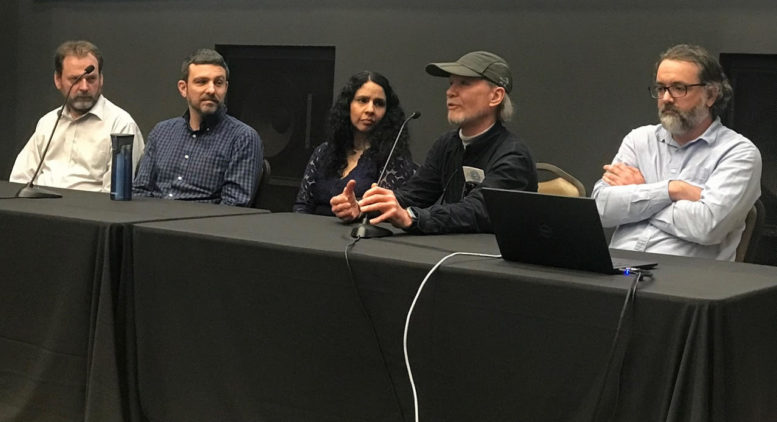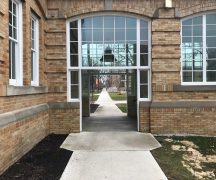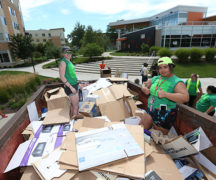By JULIE CARLE
BG Independent News
The influx of blue-green algae in Lake Erie has been causing toxic algal blooms for decades that impact water quality, recreation and tourism, and health. “The Erie Situation,” a documentary film about the Lake Erie algal blooms, was recently screened at Bowling Green State University’s Union Theater.
The stories shared in the film, based on the 2014 Toledo water crisis event, were alarming. Ken Sabin, a boat builder from Point Place on Lake Erie, shared how his love of the lake has dimmed because of increasing respiratory issues whenever he is boating on the lake.
Sandy Bihn, a member of the Lake Erie Waterkeeper, community-based advocates for clean and abundant water, called Lake Erie “the canary in the coal mine” foreboding the dangers to the health of the lake and the region.
The main contributing factor appears to be nitrogen and phosphorus runoff from farm fields, primarily from large animal feeding operations.
There is a contingent of Bowling Green State University scientists who are studying a variety of approaches to better understand the issues and find solutions. After the film, a panel of five BGSU researchers addressed how they are working together as well as with other universities, organizations and professionals to return environmental and economic vitality to Lake Erie and the region.
The BGSU research is part of Ohio Gov. Mike DeWine’s H2Ohio water quality initiative.
“We are now part of the focus for the Ohio wetlands monitoring program, trying to determine how effective wetlands are at reducing the amount of phosphorus and nitrogen that are being transported into the neighboring watershed,” said Dr. W. Robert Midden, emeritus professor of chemistry.
This area was once one of the largest wetlands in the country that was converted to fertile farmland. “By converting part of the farmland back into filter systems (wetlands) or eliminating some of the phosphorus, we might be able to help reduce the problem, but we need to know how effective they are. That is what our research is aimed at,” he explained.
Researching wetlands “is an essential part of this effort to find solutions, but by no means do we expect wetlands to be the only solution,” Midden said.
One of the questions brought up in the film–are wetlands the best solution or is changing farm practices the best solution?
“That’s one of the things we are hoping to understand with this wetlands monitoring,” said Dr. Kevin McCluney, associate professor of biological sciences who collaborates with many of the faculty members involved in this important research.
The wetland monitoring team is trying to see how effective these wetlands are at reducing the nutrients.
“In the pilot watershed project, if we get all the farmers in an entire watershed to adopt these best management practices, can we reduce the actual phosphorus coming out of the watershed enough?” McCluney asked.
One of his studies uses isotopes “to understand the cycling of phosphorus in the soil and how different best management practices, like cover crops and injection of fertilizer underground, can influence the cycling of phosphorus in the soils,” McCluney said.
Isotopes are also being used to determine how much of the phosphorus in the water is from inorganic fertilizers versus other sources, including manure. “We are trying to determine how much is coming from the CAFOs (concentrated animal feeding operations)” he said.
Dr. Angélica Vázquez-Ortega, assistant professor in the School of Earth, Environment and Society, is involved in the pilot project to study different best management practices (BMP) aimed at reducing phosphorus loads into the watersheds.
”The idea is to put in place about three percent of farmland in a specific BMP to lower the inputs of phosphates,” she said. “This is just the beginning of a five-year project, so there is no data yet.”
Despite one person in the film vehemently opposing the use of dredge materials near her home, Vázquez-Ortega said not all dredge materials is toxic. She is researching the environmental effects of dredged material on soil health, crop yield, inorganic and organic contaminants bioaccumulation in grains and nutrient export into waterways.
Dr. James Metcalf, associate professor of biological sciences, is interested in the compounds of the algal blooms and how they can affect human and animal health.
“My research has been involved with the possibility of developing diseases such as Alzheimer’s and ALS from exposure to these compounds. We know if you drink the water and eat the fish there is potential for risk. I would like to look at the airborne toxins. My hope is to try to understand what the mix of compounds that is present in these blooms may do to animal and human health both short-term and long-term,” he said.
Dr. Kevin Neves, assistant teaching professor of biological sciences, has an interest in the fish health of the lake. His research lab studies the development of integrated multi-trophic aquaponics systems. They have developed a system to reclaim nutrient-rich tile drain water from agricultural fields and use it to grow fish and plants.
A question was asked about how the 40% reduction goal was established by the state. Panel moderator Dr. George Bullerjahn, emeritus professor of biological sciences and director of the Great Lakes Center for Fresh Waters and Human Health, explained there is variability in the blooms every year.
“Some years it’s very intense and some years there is a much-reduced bloom. Typically the reduced blooms are associated with drier years and drier springs,” he said.
The 40% rate was modeled after two years – 2004 and 2012 – when a 40% lower nutrient load resulted in little to no algal blooms. “A lot of work is going on to see if that is actually enough to make a difference,” Bullerjahn said.





